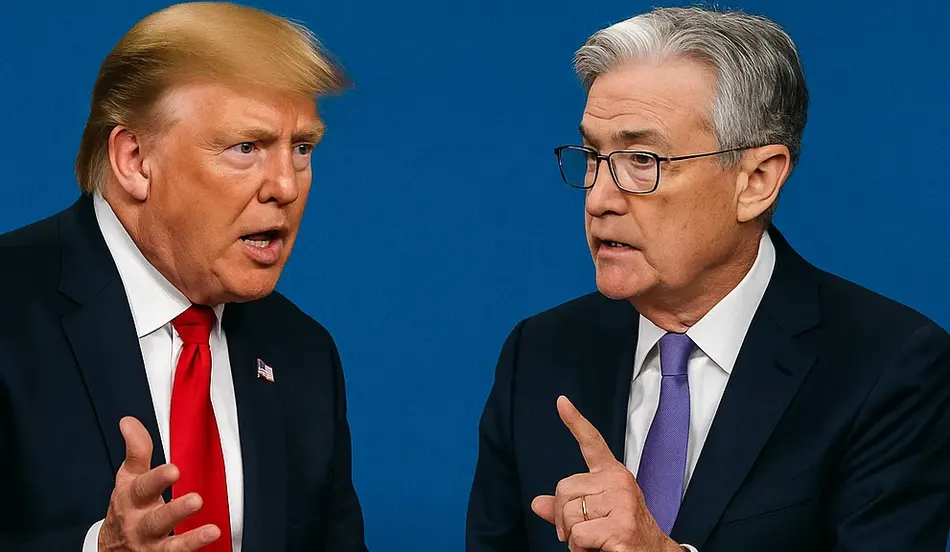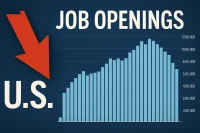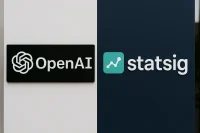President Trump Escalates Criticism of Federal Reserve as Economic Policies Hang in Balance
The ongoing tension between President Trump and Federal Reserve Chair Jerome Powell has intensified as critical economic decisions loom on the horizon. With a tax and spending package in flux and trade deal deadlines approaching, the President has publicly criticized Powell’s reluctance to lower interest rates, claiming the delay is costing the American economy billions.
Trump’s Direct Message to Powell: “You Are Too Late”
In an unprecedented move highlighting the strained relationship between the White House and the Federal Reserve, President Trump sent a pointed note to Jerome Powell stating, “Jerome, you are, as usual, too late. You have cost the USA a fortune and continue to do so. You should lower the rate by a lot. Hundreds of billions of dollars are being lost and there is no inflation.”
This direct communication breaks with the traditional independence maintained between presidential administrations and the Federal Reserve, raising concerns among economic experts about potential political influence on monetary policy decisions.
Understanding the Federal Reserve’s Dual Mandate
The Federal Reserve operates under two Congressional mandates: maximizing employment and ensuring price stability. Interest rates serve as one of the primary tools available to the Fed in fulfilling these obligations.
Currently, economic indicators show:
– Unemployment rate at a historically low 4.2%
– Inflation slightly above the Fed’s 2% target
These metrics influence the Federal Open Market Committee’s (FOMC) decisions regarding interest rate adjustments, which Powell emphasized are not made unilaterally but through a committee of 12 voting members who meet eight times annually.
Tariffs and Inflation: The Economic Ripple Effect
During recent congressional testimony, Powell made significant remarks about the impact of the President’s tariff policies on monetary decisions:
“In effect, we went on hold when we saw the size of the tariffs and where and essentially all inflation forecasts for the United States went up materially as a consequence of the tariffs.”
This statement directly connects the administration’s trade policies with the Fed’s cautious approach to interest rate cuts, suggesting that tariffs have complicated the inflation outlook and consequently influenced monetary policy decisions.
President Trump has contested these forecasts, claiming they’ve been proven wrong while simultaneously noting that many of his tariffs “haven’t even kicked in yet.” Most tariffs have been temporarily reduced to 10% until July 9th, creating uncertainty about future inflation trends.
The Federal Open Market Committee: Beyond Powell’s Authority
While President Trump’s criticism focuses on Powell personally, monetary policy decisions are made collectively by the Federal Open Market Committee (FOMC). This 12-member voting body meets eight times per year to determine whether rates should increase, decrease, or remain unchanged.
Powell’s term as chair concludes next May, raising questions about potential leadership changes at the Federal Reserve. Treasury Secretary Scott Bessent, mentioned as a possible replacement, has already weighed in on the current situation:
“They made a lot of mistakes in 2022 by waiting too long to hike, and maybe they’re doing the mirror image of that by waiting too long to cut.”
Future Rate Cuts: What to Expect
Despite the public pressure, Powell maintains that the majority of the FOMC believes interest rate cuts will be appropriate later this year, though specific timing remains uncertain. When questioned about the President’s personal attacks, Powell responded professionally, stating he remains focused on fulfilling his responsibilities.
Economic analysts suggest that several factors will influence the timing and magnitude of potential rate cuts:
– Continued inflation trends
– Employment data
– Global economic conditions
– Implementation of tariff policies
The Economic Stakes of Delayed Action
The dispute over interest rate timing occurs against a backdrop of significant economic policy developments:
– A tax and spending package currently moving through Congress
– Impending trade deal deadlines
– Concerns about maintaining economic growth momentum
– Debates over the actual impact of current interest rates on business investment
How Interest Rate Decisions Affect Your Finances
Interest rate adjustments by the Federal Reserve have far-reaching impacts on everyday Americans:
Mortgage Rates
When the Fed lowers rates, mortgage rates typically follow, making homeownership more affordable and potentially stimulating the housing market.
Credit Card Debt
Lower interest rates can reduce the cost of carrying credit card balances, providing relief to millions of Americans struggling with high-interest debt.
Retirement Savings
Interest rate decisions influence stock market performance and bond yields, directly affecting retirement accounts and investment strategies for millions of Americans.
Find Financial Sector Jobs on WhatJobs
Political Implications of Fed Independence
The public dispute between the President and the Federal Reserve Chair raises important questions about central bank independence:
Historical Precedent
While presidents have historically preferred lower interest rates to boost economic growth during their terms, the degree of public criticism has varied significantly across administrations.
Market Confidence
Financial markets closely monitor the relationship between the White House and the Fed, as perceived political influence can affect investor confidence and market stability.
Global Standing
The independence of the Federal Reserve is considered a cornerstone of American economic credibility internationally, with potential implications for the dollar’s status as the world’s reserve currency.
Hiring?
Post Financial Sector Jobs for Free with WhatJobs
Are you looking to hire qualified financial professionals who understand monetary policy and economic trends? Post your job openings for free on WhatJobs and connect with talented candidates who can navigate today’s complex economic landscape.
Post a Job NowExpert Perspectives on the Fed-White House Tension
Economic experts remain divided on whether the Federal Reserve should accelerate interest rate cuts:
– Pro-Cut Perspective: Lower rates could stimulate business investment, support continued job growth, and prevent economic slowdown.
– Cautious Approach Advocates: Premature cuts could reignite inflation, creating longer-term economic instability that would ultimately harm consumers.
– Middle-Ground Analysis: Targeted, gradual cuts might balance growth needs while monitoring inflation indicators.
FAQ: Federal Reserve Interest Rate Cuts
What factors does the Federal Reserve consider when deciding on interest rate cuts?
The Federal Reserve examines multiple economic indicators before implementing Federal Reserve interest rate cuts, including inflation data, unemployment figures, GDP growth, consumer spending patterns, and global economic conditions. The FOMC analyzes these factors collectively to determine whether lower interest rates would support their dual mandate of price stability and maximum employment.
How do Federal Reserve interest rate cuts affect mortgage rates?
Federal Reserve interest rate cuts typically lead to lower mortgage rates, though the relationship isn’t always immediate or proportional. When the Fed reduces its benchmark rate, lenders generally follow by decreasing mortgage rates, making home purchases and refinancing more affordable for consumers. This relationship between Federal Reserve interest rate cuts and mortgage costs can significantly impact housing market activity.
Will Federal Reserve interest rate cuts help reduce inflation?
Contrary to common belief, Federal Reserve interest rate cuts are not typically implemented to reduce inflation—they’re more often used to stimulate economic growth when inflation is already under control. The Federal Reserve interest rate cuts discussion currently centers on whether inflation has stabilized sufficiently to warrant stimulative monetary policy without risking price instability.
How might Federal Reserve interest rate cuts impact my investments?
Federal Reserve interest rate cuts generally create a favorable environment for stock markets and real estate investments while potentially reducing returns on fixed-income investments like bonds and CDs. Investors should consider rebalancing portfolios in anticipation of Federal Reserve interest rate cuts, possibly increasing allocation to growth-oriented assets while maintaining sufficient diversification to manage risk.
When will the Federal Reserve likely implement the next interest rate cut?
While Powell has indicated that Federal Reserve interest rate cuts are expected later this year, the specific timing remains uncertain. Market analysts are closely monitoring upcoming economic data releases and FOMC meeting schedules to predict when Federal Reserve interest rate cuts might begin, with many forecasting initial reductions in the third or fourth quarter of 2024.
This comprehensive analysis of the tension between President Trump and Federal Reserve Chair Jerome Powell highlights the complex interplay between politics, monetary policy, and economic outcomes. As interest rate decisions continue to shape financial markets and everyday finances, understanding the factors influencing these choices becomes increasingly important for investors, businesses, and consumers alike.




